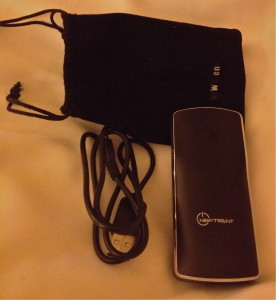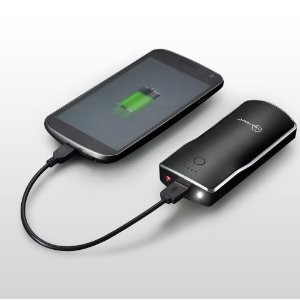 The New Trent iTorch IMP52D is a portable, rechargeable, external lithium battery I use to recharge my cell phone (an iPhone). It is compatible with any device (i.e. phone, MP3 player, tablet) that uses a USB plug.
The New Trent iTorch IMP52D is a portable, rechargeable, external lithium battery I use to recharge my cell phone (an iPhone). It is compatible with any device (i.e. phone, MP3 player, tablet) that uses a USB plug.
Currently I am travelling for work…again. There are many things on my ‘must pack’ list these days, but ever since Trace bought each of us an iTorch about a year ago, I don’t go anywhere without it. It stays in my purse and goes with me pretty much everywhere.
The iTorch is 3.5” x 1.5” x1”; not tiny, but certainly a reasonable size. There are four blue lights, one indicates the iTorch is charging a device, and the other three indicate the level of charge remaining. It also includes a built-in red laser pointer and an LED light; just in case you need a laser pointer or emergency flashlight (repetitive and redundant!). It comes in a handy drawstring bag with a cord to charge the iTorch itself. In order to charge our phones we had to supply the needed USB iPhone cord.
The iTorch is advertised as having 3.5x the normal iPhone charge. I honestly don’t know if this is true or not as I’ve never used the iTorch to its full capacity. Even when I’ve needed to recharge my phone multiple times before I could recharge the iTorch, I’ve never fully depleted the iTorch charge. For this trip in particular it’s been useful as a charger in the car because I totally forgot to bring a car charger for the rental car. It’s also been handy during the day as I’m in training sessions and I can charge my phone as needed without crawling all over the place looking for a wall plug.
Trace first heard about the iTorch from Steven Harris’ site: battery1234.com — which lists many useful devices, all of which Steven has thoroughly tested and personally recommends. We own many items on this list, it is our go-to list when we want to expand our back-up energy capabilities.
Recommendation
 I highly recommend the iTorch, for travel, for the prepper, but also as a simply back-up charger. I can’t count the number of times it’s allowed me to charge up my phone after a day in someone else’s car, or in training, or at an airport.
I highly recommend the iTorch, for travel, for the prepper, but also as a simply back-up charger. I can’t count the number of times it’s allowed me to charge up my phone after a day in someone else’s car, or in training, or at an airport.
It’s reasonably priced (about $40) and a compact, and durable, enough to carry in a purse or backpack on regular basis (weights 4.5 ounces). And we’re not the only ones who like it, it has an Amazon Customer Review rating of 4.11 starts (of 5) with over 900 reviews.
As Trace has said before: as a prepper–trying to be prepared in case of emergencies or disasters–communication is very important. Sure the cell network can go down, but if it’s up and available it’d suck if you couldn’t access it just because your phone’s battery is dead. This is a product that can help prevent that from happening.





